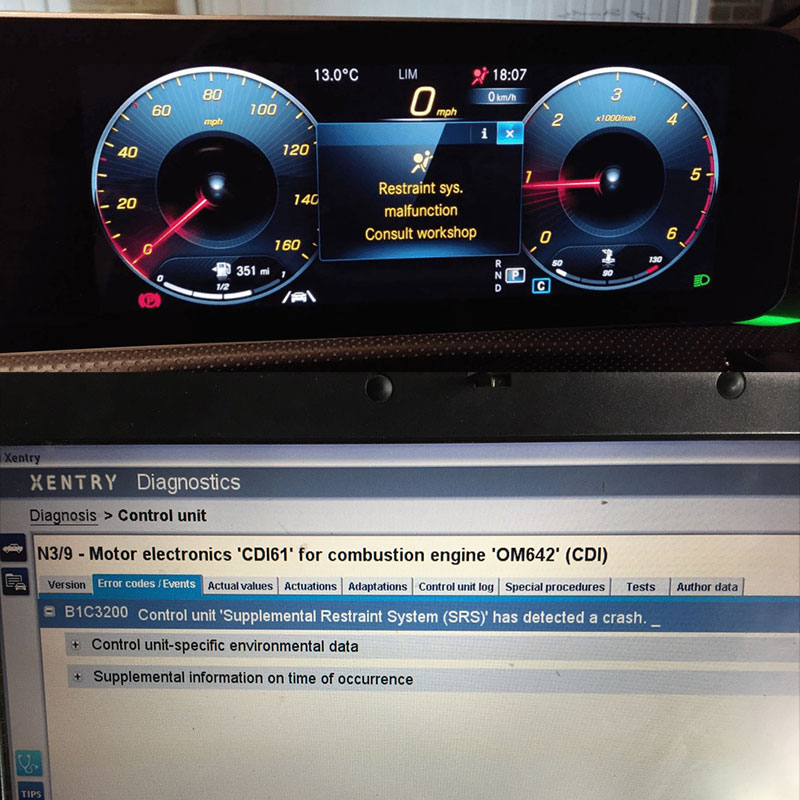
What Causes The 29db BMW Code And How To Fix It?
Table of Content
- 1. What Does The 29db BMW Code Mean?
- 2. What Are The Common Symptoms Associated With The 29db BMW Code?
- 3. What Are The Potential Causes Of The 29db BMW Code?
- 4. How Can I Diagnose The 29db BMW Code?
- 5. What Tools Are Needed To Diagnose And Repair The 29db BMW Code?
- 6. What Are The Steps To Repair The 29db BMW Code?
- 7. How Does A Faulty Crankshaft Position Sensor Cause The 29db BMW Code?
- 8. How Does A Faulty Camshaft Position Sensor Cause The 29db BMW Code?
- 9. What Role Does The Timing Chain Play In The 29db BMW Code?
- 10. How Does The VANOS System Affect The 29db BMW Code?
- 11. How Does Low Oil Pressure Contribute To The 29db BMW Code?
- 12. What Role Does The Engine Wiring Harness Play In The 29db BMW Code?
- 13. Can I Fix The 29db BMW Code Myself, Or Do I Need A Professional?
- 14. What Are The Risks Of Ignoring The 29db BMW Code?
- 15. What Is The Cost To Repair The 29db BMW Code?
- 16. How Can AutoExplain.com Help Me With The 29db BMW Code?
- 17. What Other Codes Might Appear With The 29db BMW Code?
- 18. How Can I Prevent The 29db BMW Code From Recurring?
- 19. What Is The Function Of The Crankshaft And Camshaft Position Sensors?
- 20. What Happens If The Timing Chain Breaks While Driving?
- 21. Can Incorrect Engine Oil Cause The 29db BMW Code?
- 22. How Often Should I Replace The Crankshaft And Camshaft Position Sensors?
- 23. What Is The VANOS System And How Does It Work?
- 24. What Are Common Problems With The VANOS System?
- 25. How Do I Test The VANOS System?
- FAQ About 29db BMW Code
- 1. What is the 29db BMW code?
- 2. What are the common symptoms of the 29db BMW code?
- 3. What are the potential causes of the 29db BMW code?
- 4. Can I drive my BMW with the 29db code?
- 5. How do I diagnose the 29db BMW code?
- 6. How much does it cost to repair the 29db BMW code?
- 7. Can low oil pressure cause the 29db BMW code?
- 8. What is the VANOS system?
- 9. How does a faulty camshaft position sensor cause the 29db code?
- 10. Where can I get expert help with the 29db BMW code?
The 29db Bmw Code indicates “Irregular Running, Segment Timing,” suggesting potential issues with the engine’s crankshaft or camshaft timing. Fixing this promptly can prevent severe engine damage, enhance vehicle performance, and ensure optimal fuel efficiency. AutoExplain.com offers expert remote diagnostic and programming services to accurately pinpoint the root cause and guide you through the necessary repairs.
1. What Does The 29db BMW Code Mean?
The 29db Bmw Code signifies “Irregular Running, Segment Timing,” which suggests that the engine control unit (ECU) has detected inconsistencies in the timing between the crankshaft and camshaft. This irregular timing can lead to engine misfires, reduced performance, and potential damage to the engine’s internal components. Resolving this issue promptly is crucial for maintaining the health and efficiency of your BMW.
- Crankshaft and Camshaft Timing: The crankshaft and camshaft must operate in precise synchronization to ensure that the engine’s valves open and close at the correct times relative to the piston’s position. Any deviation from this synchronization can disrupt the combustion process.
- Engine Control Unit (ECU): The ECU monitors the signals from the crankshaft and camshaft position sensors to ensure they align within specified parameters. If the ECU detects a discrepancy, it triggers the 29db code.
2. What Are The Common Symptoms Associated With The 29db BMW Code?
Common symptoms associated with the 29db BMW code include engine misfires, rough idling, reduced engine power, difficulty starting the engine, and the illumination of the check engine light. These symptoms can significantly affect your BMW’s drivability and performance. Addressing them promptly is essential to prevent further damage.
- Engine Misfires: Irregular timing can cause one or more cylinders to misfire, leading to a noticeable decrease in engine performance.
- Rough Idling: The engine may idle roughly or stall, especially when the vehicle is stationary.
- Reduced Engine Power: The vehicle may exhibit a noticeable lack of power, particularly during acceleration.
- Difficulty Starting: The engine may take longer than usual to start, or it may fail to start altogether.
- Check Engine Light: The check engine light on the dashboard will illuminate, indicating that the ECU has detected a problem.
3. What Are The Potential Causes Of The 29db BMW Code?
Potential causes of the 29db BMW code include a faulty crankshaft position sensor, a faulty camshaft position sensor, a stretched or broken timing chain, a malfunctioning VANOS system, low oil pressure, or issues with the engine wiring harness. Accurate diagnosis is essential to identify the specific cause and implement the correct repair.
- Faulty Crankshaft Position Sensor: The crankshaft position sensor provides the ECU with information about the crankshaft’s position and speed. A faulty sensor can send incorrect data, leading to timing issues.
- Faulty Camshaft Position Sensor: Similarly, the camshaft position sensor informs the ECU about the camshaft’s position. A malfunctioning sensor can disrupt the synchronization between the crankshaft and camshaft.
- Stretched or Broken Timing Chain: The timing chain connects the crankshaft and camshaft, ensuring they rotate in sync. Over time, the timing chain can stretch or break, causing timing misalignment.
- Malfunctioning VANOS System: The VANOS (Variable Camshaft Timing) system adjusts the camshaft timing to optimize engine performance. A malfunctioning VANOS system can lead to timing irregularities.
- Low Oil Pressure: The VANOS system relies on oil pressure to function correctly. Low oil pressure can impair its ability to adjust the camshaft timing.
- Engine Wiring Harness Issues: Damaged or corroded wiring in the engine wiring harness can disrupt the signals from the crankshaft and camshaft position sensors, leading to the 29db code.
4. How Can I Diagnose The 29db BMW Code?
Diagnosing the 29db BMW code involves using an OBD-II scanner to read the fault codes, visually inspecting the crankshaft and camshaft position sensors, checking the timing chain for wear or damage, testing the VANOS system, and examining the engine wiring harness for any issues. A systematic approach ensures accurate identification of the problem.
- OBD-II Scanner: Use an OBD-II scanner to confirm the presence of the 29db code and check for any other related fault codes.
- Visual Inspection of Sensors: Inspect the crankshaft and camshaft position sensors for any signs of physical damage, such as cracks or corrosion.
- Timing Chain Inspection: Examine the timing chain for wear, stretching, or damage. This may require removing the valve cover for a thorough inspection.
- VANOS System Testing: Test the VANOS system to ensure it is functioning correctly. This can involve using a diagnostic tool to monitor the VANOS solenoid activation and camshaft angle adjustments.
- Engine Wiring Harness Examination: Check the engine wiring harness for any damaged, corroded, or loose wires that could be disrupting the sensor signals.
5. What Tools Are Needed To Diagnose And Repair The 29db BMW Code?
Tools needed to diagnose and repair the 29db BMW code include an OBD-II scanner, a multimeter, a timing chain alignment tool, a socket set, a wrench set, and a diagnostic computer with BMW-specific software. Having the right tools ensures efficient and accurate repairs.
- OBD-II Scanner: To read and clear diagnostic trouble codes.
- Multimeter: To test the electrical continuity and voltage of the crankshaft and camshaft position sensors.
- Timing Chain Alignment Tool: To ensure proper alignment of the crankshaft and camshaft during timing chain replacement.
- Socket Set and Wrench Set: To remove and install various engine components.
- Diagnostic Computer with BMW-Specific Software: To perform advanced diagnostics and programming of the VANOS system and other engine control functions.
6. What Are The Steps To Repair The 29db BMW Code?
Steps to repair the 29db BMW code include replacing faulty crankshaft or camshaft position sensors, replacing a stretched or broken timing chain, repairing or replacing a malfunctioning VANOS system, repairing any issues with the engine wiring harness, and performing an engine oil change to ensure proper lubrication. Each step must be performed with precision to resolve the underlying issue.
- Replace Faulty Sensors: If either the crankshaft or camshaft position sensor is found to be faulty, replace it with a new, OEM-quality sensor.
- Replace Timing Chain: If the timing chain is stretched or broken, replace it with a new timing chain kit, including sprockets and guides.
- Repair or Replace VANOS System: If the VANOS system is malfunctioning, repair or replace the faulty components, such as the VANOS solenoids or actuators.
- Repair Wiring Harness: If there are any issues with the engine wiring harness, repair or replace the damaged wires or connectors.
- Perform Engine Oil Change: Ensure the engine oil is clean and at the correct level to provide adequate lubrication for the VANOS system and other engine components.
Alt text: Visual depiction of a BMW camshaft position sensor, crucial for engine timing and diagnosed during 29db BMW code troubleshooting.
7. How Does A Faulty Crankshaft Position Sensor Cause The 29db BMW Code?
A faulty crankshaft position sensor can cause the 29db BMW code by sending inaccurate or intermittent signals to the ECU, disrupting the engine’s timing and leading to misfires and performance issues. The ECU relies on this sensor to precisely manage fuel injection and ignition timing.
- Inaccurate Signals: A faulty sensor may send incorrect data about the crankshaft’s position, causing the ECU to miscalculate the timing of fuel injection and ignition.
- Intermittent Signals: The sensor may send intermittent signals, leading to sporadic timing issues and engine misfires.
- Disrupted Engine Timing: The ECU relies on the crankshaft position sensor to precisely manage fuel injection and ignition timing. A faulty sensor disrupts this process, leading to the 29db code.
8. How Does A Faulty Camshaft Position Sensor Cause The 29db BMW Code?
A faulty camshaft position sensor can cause the 29db BMW code by providing incorrect information about the camshaft’s position, leading to timing misalignment and affecting the engine’s valve operation. This misalignment disrupts the combustion process and triggers the fault code.
- Incorrect Information: A faulty sensor provides the ECU with incorrect data about the camshaft’s position, leading to timing misalignment.
- Valve Operation Issues: The camshaft controls the opening and closing of the engine’s valves. Incorrect camshaft position information can affect the engine’s valve operation, disrupting the combustion process.
- Timing Misalignment: The camshaft and crankshaft must operate in precise synchronization. A faulty camshaft position sensor disrupts this synchronization, triggering the 29db code.
9. What Role Does The Timing Chain Play In The 29db BMW Code?
The timing chain plays a crucial role in the 29db BMW code because it synchronizes the crankshaft and camshaft. A stretched or broken timing chain can cause timing misalignment, leading to engine misfires and reduced performance. Maintaining the timing chain’s integrity is vital for proper engine operation.
- Synchronization of Crankshaft and Camshaft: The timing chain connects the crankshaft and camshaft, ensuring they rotate in sync.
- Timing Misalignment: A stretched or broken timing chain can cause timing misalignment, disrupting the precise synchronization between the crankshaft and camshaft.
- Engine Misfires and Reduced Performance: Timing misalignment can lead to engine misfires, reduced engine power, and other performance issues, triggering the 29db code.
10. How Does The VANOS System Affect The 29db BMW Code?
The VANOS system affects the 29db BMW code because it controls the variable valve timing. A malfunctioning VANOS system can cause timing irregularities, leading to the 29db code and affecting engine performance. Proper functioning of the VANOS system is essential for optimizing engine efficiency and power.
- Variable Valve Timing Control: The VANOS system adjusts the camshaft timing to optimize engine performance under various driving conditions.
- Timing Irregularities: A malfunctioning VANOS system can cause timing irregularities, leading to the 29db code.
- Engine Performance Issues: Problems with the VANOS system can affect engine performance, including reduced power, poor fuel economy, and rough idling.
11. How Does Low Oil Pressure Contribute To The 29db BMW Code?
Low oil pressure can contribute to the 29db BMW code because the VANOS system relies on adequate oil pressure to function correctly. Insufficient oil pressure can impair the VANOS system’s ability to adjust the camshaft timing, leading to timing irregularities.
- VANOS System Reliance on Oil Pressure: The VANOS system uses oil pressure to adjust the camshaft timing.
- Impaired VANOS Function: Low oil pressure can impair the VANOS system’s ability to adjust the camshaft timing, leading to timing irregularities.
- Timing Irregularities: When the VANOS system cannot function correctly due to low oil pressure, it can cause timing irregularities, triggering the 29db code.
12. What Role Does The Engine Wiring Harness Play In The 29db BMW Code?
The engine wiring harness plays a critical role in the 29db BMW code because it transmits signals from the crankshaft and camshaft position sensors to the ECU. Damaged or corroded wiring can disrupt these signals, leading to timing issues and triggering the fault code.
- Signal Transmission: The engine wiring harness transmits signals from the crankshaft and camshaft position sensors to the ECU.
- Disrupted Signals: Damaged or corroded wiring can disrupt these signals, causing the ECU to receive inaccurate or intermittent data.
- Timing Issues: Disruptions in the sensor signals can lead to timing issues, triggering the 29db code.
13. Can I Fix The 29db BMW Code Myself, Or Do I Need A Professional?
While some experienced DIYers might attempt to fix the 29db BMW code themselves, it often requires professional expertise and specialized tools. The complexity of modern BMW engines and the precision required for timing adjustments make it a challenging task for non-professionals. If you’re unsure, it’s best to consult with a qualified technician.
- Complexity of BMW Engines: Modern BMW engines are complex, with intricate timing systems that require precise adjustments.
- Specialized Tools: Diagnosing and repairing the 29db code often requires specialized tools, such as timing chain alignment tools and diagnostic computers with BMW-specific software.
- Risk of Further Damage: Incorrect repairs can cause further damage to the engine, leading to more costly repairs in the long run.
14. What Are The Risks Of Ignoring The 29db BMW Code?
Ignoring the 29db BMW code can lead to severe engine damage, reduced fuel efficiency, increased emissions, and potential safety hazards. Addressing the issue promptly is essential to prevent these consequences and maintain your BMW’s reliability.
- Severe Engine Damage: Continued operation with timing issues can cause significant damage to the engine’s internal components, such as the pistons, valves, and cylinder head.
- Reduced Fuel Efficiency: Timing irregularities can lead to inefficient combustion, resulting in reduced fuel economy.
- Increased Emissions: Misfires and incomplete combustion can increase harmful emissions, contributing to environmental pollution.
- Potential Safety Hazards: Severe engine problems can lead to unexpected breakdowns, posing safety hazards, especially at high speeds.
15. What Is The Cost To Repair The 29db BMW Code?
The cost to repair the 29db BMW code can vary widely, depending on the underlying cause and the extent of the damage. Minor repairs, such as replacing a faulty sensor, may cost a few hundred dollars, while major repairs, such as replacing the timing chain or VANOS system, can cost several thousand dollars. Obtaining an accurate diagnosis and estimate from a trusted mechanic is crucial.
- Minor Repairs: Replacing a faulty crankshaft or camshaft position sensor may cost between $200 and $500, including parts and labor.
- Major Repairs: Replacing the timing chain can range from $1,500 to $3,000, depending on the engine model and labor rates. Repairing or replacing the VANOS system can cost between $1,000 and $4,000.
- Diagnostic Costs: Diagnostic fees can range from $100 to $200, depending on the shop’s rates and the complexity of the diagnosis.
16. How Can AutoExplain.com Help Me With The 29db BMW Code?
AutoExplain.com can help you with the 29db BMW code by providing expert remote diagnostic and programming services. Our experienced technicians can accurately diagnose the root cause of the issue and guide you through the necessary repairs, saving you time and money. We offer support via WhatsApp, email, and other online platforms, ensuring you receive timely and effective assistance.
- Expert Remote Diagnostics: Our technicians can remotely access your vehicle’s diagnostic data to identify the underlying cause of the 29db code.
- Programming Services: We offer programming services for the VANOS system and other engine control functions, ensuring optimal performance.
- Step-by-Step Guidance: We provide step-by-step guidance on how to perform the necessary repairs, helping you avoid costly mistakes.
- Convenient Support: Our support team is available via WhatsApp, email, and other online platforms to answer your questions and provide assistance.
17. What Other Codes Might Appear With The 29db BMW Code?
Other codes that might appear with the 29db BMW code include misfire codes (e.g., P0300, P0301), camshaft position sensor codes (e.g., P0340, P0341), crankshaft position sensor codes (e.g., P0335, P0336), and VANOS system codes (e.g., P1525, P1526). These codes can provide additional insights into the underlying issue and help narrow down the diagnosis.
- Misfire Codes: Codes such as P0300 (Random Misfire Detected) and P0301-P0306 (Misfire Detected in Cylinder 1-6) often accompany the 29db code due to timing irregularities.
- Camshaft Position Sensor Codes: Codes like P0340 (Camshaft Position Sensor A Circuit) and P0341 (Camshaft Position Sensor A Circuit Range/Performance) indicate issues with the camshaft position sensor.
- Crankshaft Position Sensor Codes: Codes such as P0335 (Crankshaft Position Sensor A Circuit) and P0336 (Crankshaft Position Sensor A Circuit Range/Performance) point to problems with the crankshaft position sensor.
- VANOS System Codes: Codes like P1525 and P1526 indicate issues with the VANOS system’s performance or solenoid control.
18. How Can I Prevent The 29db BMW Code From Recurring?
To prevent the 29db BMW code from recurring, ensure regular maintenance, use high-quality engine oil, replace the timing chain at recommended intervals, and address any engine issues promptly. Consistent care can extend the life of your engine and prevent future timing-related problems.
- Regular Maintenance: Follow the manufacturer’s recommended maintenance schedule, including oil changes, filter replacements, and spark plug replacements.
- High-Quality Engine Oil: Use high-quality engine oil that meets BMW’s specifications to ensure proper lubrication of the engine components, including the VANOS system.
- Timing Chain Replacement: Replace the timing chain at the recommended interval (typically between 80,000 and 120,000 miles) to prevent stretching or breakage.
- Prompt Issue Resolution: Address any engine issues promptly to prevent them from escalating and causing further damage.
19. What Is The Function Of The Crankshaft And Camshaft Position Sensors?
The crankshaft position sensor monitors the position and speed of the crankshaft, providing essential data to the ECU for managing ignition and fuel injection timing. The camshaft position sensor tracks the position of the camshaft, helping the ECU synchronize valve operation with piston movement. Together, these sensors ensure precise engine timing.
- Crankshaft Position Sensor: This sensor monitors the position and speed of the crankshaft, providing essential data to the ECU for managing ignition and fuel injection timing.
- Camshaft Position Sensor: This sensor tracks the position of the camshaft, helping the ECU synchronize valve operation with piston movement.
- Precise Engine Timing: The data from both sensors is crucial for maintaining precise engine timing, which is essential for optimal performance and fuel efficiency.
20. What Happens If The Timing Chain Breaks While Driving?
If the timing chain breaks while driving, it can cause catastrophic engine damage, including bent valves, damaged pistons, and cylinder head damage. The engine will likely stall immediately, and attempting to restart it can exacerbate the damage. In such cases, professional repair is essential.
- Catastrophic Engine Damage: A broken timing chain can cause significant damage to the engine’s internal components, such as the valves, pistons, and cylinder head.
- Immediate Engine Stall: The engine will likely stall immediately when the timing chain breaks, as the crankshaft and camshaft are no longer synchronized.
- Exacerbated Damage: Attempting to restart the engine after a timing chain failure can exacerbate the damage, as the pistons may collide with the valves.
Alt text: A BMW engine timing chain, essential for synchronizing crankshaft and camshaft, shown to illustrate a critical component related to the 29db BMW code.
21. Can Incorrect Engine Oil Cause The 29db BMW Code?
Yes, using incorrect engine oil can contribute to the 29db BMW code, particularly if the oil does not meet BMW’s specifications. Incorrect oil can lead to inadequate lubrication of the VANOS system, impairing its ability to adjust camshaft timing and triggering the fault code.
- Inadequate VANOS Lubrication: Incorrect engine oil may not provide adequate lubrication for the VANOS system, leading to sluggish or erratic performance.
- Impaired Camshaft Timing Adjustment: The VANOS system relies on proper oil viscosity and flow to adjust camshaft timing effectively. Incorrect oil can impair this process.
- Fault Code Trigger: When the VANOS system cannot function correctly due to inadequate lubrication, it can cause timing irregularities, triggering the 29db code.
22. How Often Should I Replace The Crankshaft And Camshaft Position Sensors?
Crankshaft and camshaft position sensors should be replaced as needed, rather than on a fixed schedule. If a sensor fails or exhibits symptoms of malfunction, such as intermittent engine stalling or misfires, it should be replaced promptly. Regular diagnostics can help identify potential sensor issues before they lead to more significant problems.
- As-Needed Replacement: Replace sensors only when they fail or exhibit symptoms of malfunction.
- Symptoms of Malfunction: Look for symptoms such as intermittent engine stalling, misfires, or difficulty starting the engine.
- Regular Diagnostics: Perform regular diagnostics to identify potential sensor issues before they lead to more significant problems.
23. What Is The VANOS System And How Does It Work?
The VANOS (Variable Nockenwellen Steuerung) system is a variable valve timing system used in BMW engines to optimize performance and fuel efficiency. It adjusts the timing of the intake and/or exhaust valves based on engine speed and load, allowing for improved torque at low speeds and increased horsepower at high speeds.
- Variable Valve Timing: The VANOS system adjusts the timing of the intake and/or exhaust valves to optimize engine performance.
- Engine Speed and Load Adjustment: The system adjusts valve timing based on engine speed and load, allowing for improved torque at low speeds and increased horsepower at high speeds.
- Improved Performance and Efficiency: By optimizing valve timing, the VANOS system improves engine performance, fuel efficiency, and emissions.
24. What Are Common Problems With The VANOS System?
Common problems with the VANOS system include faulty solenoids, worn seals, and clogged oil passages. These issues can lead to sluggish or erratic VANOS performance, resulting in reduced engine power, poor fuel economy, and the triggering of fault codes like the 29db BMW code.
- Faulty Solenoids: The VANOS solenoids control the flow of oil to the VANOS actuators. Faulty solenoids can cause the system to malfunction.
- Worn Seals: Worn seals can lead to oil leaks and reduced oil pressure within the VANOS system, affecting its performance.
- Clogged Oil Passages: Clogged oil passages can restrict oil flow to the VANOS actuators, impairing their ability to adjust camshaft timing.
25. How Do I Test The VANOS System?
To test the VANOS system, you can use a diagnostic computer with BMW-specific software to monitor the VANOS solenoid activation and camshaft angle adjustments. You can also perform a visual inspection of the VANOS components for any signs of damage or wear. Additionally, an oil pressure test can help identify any issues with oil supply to the VANOS system.
- Diagnostic Computer Monitoring: Use a diagnostic computer with BMW-specific software to monitor the VANOS solenoid activation and camshaft angle adjustments.
- Visual Inspection: Perform a visual inspection of the VANOS components for any signs of damage or wear.
- Oil Pressure Test: Perform an oil pressure test to identify any issues with oil supply to the VANOS system.
Is the 29db BMW code giving you a headache? Don’t waste time and money on guesswork. Contact AutoExplain.com now via WhatsApp at (+84)967469410 or email us at [email protected] for expert remote diagnostic and programming services. Let our experienced technicians quickly pinpoint the problem and guide you to a solution. Visit AutoExplain.com today and get your BMW back on the road! Office Address: 1500 N Grant ST Sten Denver, CO 80203.
FAQ About 29db BMW Code
1. What is the 29db BMW code?
The 29db BMW code indicates “Irregular Running, Segment Timing,” suggesting a timing issue between the crankshaft and camshaft.
2. What are the common symptoms of the 29db BMW code?
Common symptoms include engine misfires, rough idling, reduced engine power, and difficulty starting the engine.
3. What are the potential causes of the 29db BMW code?
Potential causes include a faulty crankshaft or camshaft position sensor, a stretched timing chain, a malfunctioning VANOS system, or low oil pressure.
4. Can I drive my BMW with the 29db code?
Driving with the 29db code is not recommended, as it can lead to severe engine damage and reduced performance.
5. How do I diagnose the 29db BMW code?
Diagnosing the 29db code involves using an OBD-II scanner, visually inspecting sensors, checking the timing chain, and testing the VANOS system.
6. How much does it cost to repair the 29db BMW code?
The cost to repair can vary from a few hundred dollars for sensor replacement to several thousand for timing chain or VANOS system repairs.
7. Can low oil pressure cause the 29db BMW code?
Yes, low oil pressure can impair the VANOS system’s function, leading to timing irregularities and the 29db code.
8. What is the VANOS system?
The VANOS system is a variable valve timing system that optimizes engine performance and fuel efficiency by adjusting valve timing.
9. How does a faulty camshaft position sensor cause the 29db code?
A faulty camshaft position sensor provides incorrect information about the camshaft’s position, leading to timing misalignment and the 29db code.
10. Where can I get expert help with the 29db BMW code?
AutoExplain.com offers expert remote diagnostic and programming services to help you resolve the 29db BMW code quickly and efficiently.

65535 Audi Fault Code: Expert Solutions and Fixes
Audi A3 Trouble Code 00796: Diagnosis, Solutions, and Expert Insights
Audi DTC 16347:014 – Expert Diagnosis and Solutions

Josh William
Josh William is a seasoned automotive expert and technical writer at AutoExplain. With a background as an automotive technician, he brings hands-on experience and deep industry knowledge to his writing.




